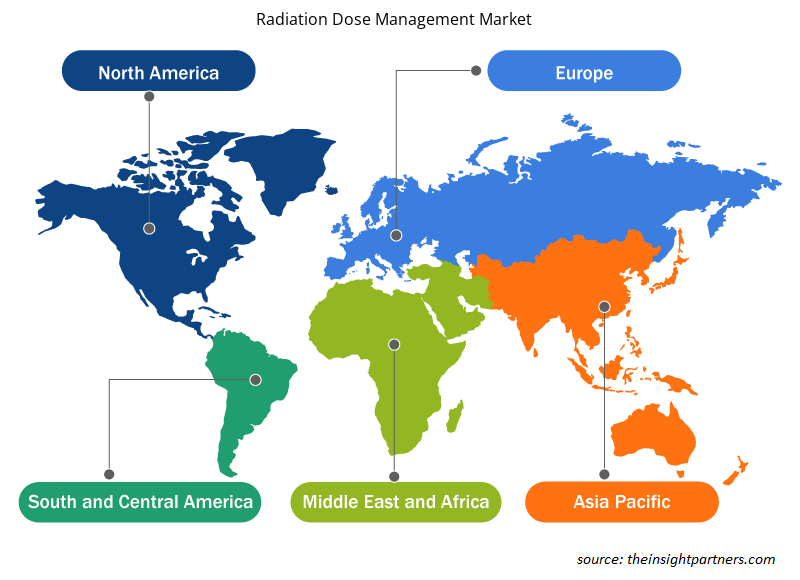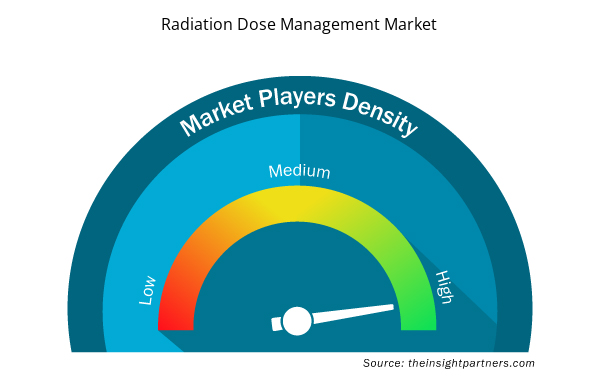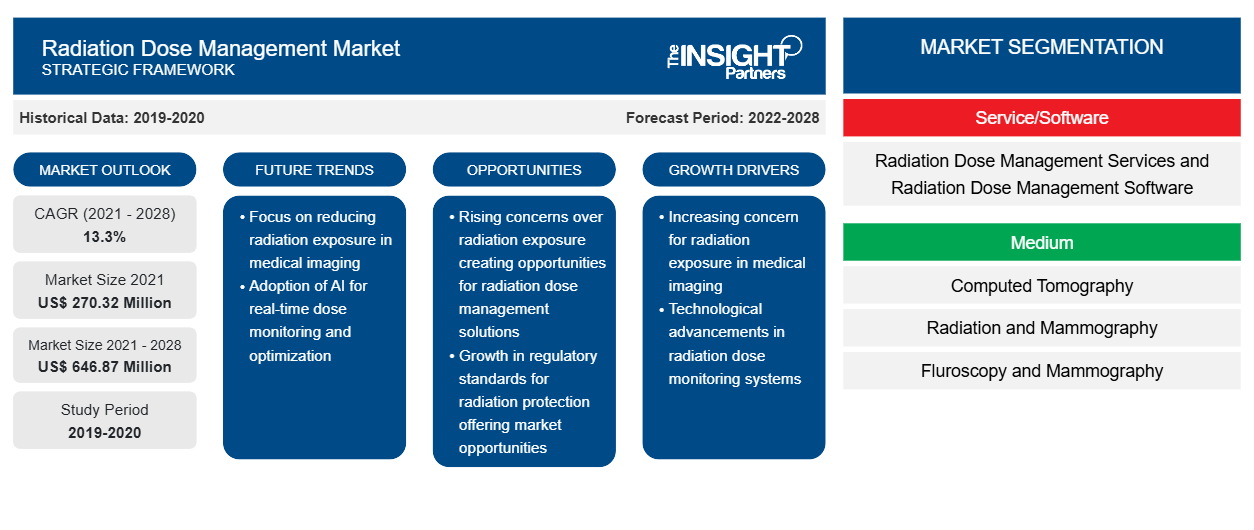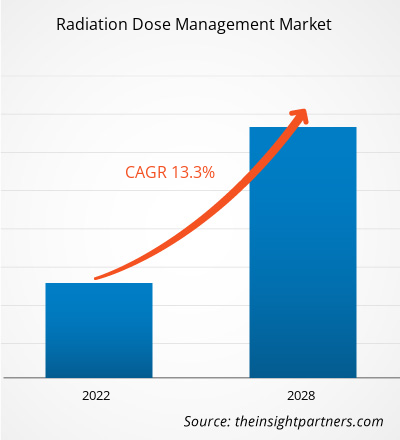Si prevede che il mercato della gestione della dose di radiazioni raggiungerà i 646,87 milioni di dollari entro il 2028, rispetto ai 270,32 milioni di dollari del 2021; si stima che crescerà a un CAGR del 13,3% nel periodo 2021-2028.
La radioterapia è una branca essenziale della scienza medica. Varie malattie come cancro, malattie cardiovascolari, ecc. vengono diagnosticate e curate tramite onde elettromagnetiche. È ampiamente utilizzata per curare diversi tipi di cancro. Tuttavia, la radioterapia ha anche effetti collaterali. Pertanto, il monitoraggio della dose di radiazioni corretta è altamente essenziale in qualsiasi procedura medica basata sulle radiazioni. La dose di radiazioni è la quantità di radiazioni emesse sul paziente. La gestione della dose di radiazioni comprende informazioni sul software di registrazione della dose di radiazioni; monitoraggio della dose del personale in tempo reale; conformità normativa; e tecnologie di riduzione della dose, come il software di ricostruzione interattiva.
La crescita del mercato della gestione della dose di radiazioni è attribuita alle crescenti preoccupazioni relative all'esposizione alle radiazioni e all'aumento dei casi di cancro che richiedono radioterapia. Tuttavia, le sfide organizzative e la mancanza di benchmarking per l'ottimizzazione della dose ostacolano la crescita del mercato.
Personalizza questo report in base alle tue esigenze
Riceverai la personalizzazione gratuita di qualsiasi report, comprese parti di questo report, o analisi a livello nazionale, pacchetto dati Excel, oltre a usufruire di grandi offerte e sconti per start-up e università
- Scopri le principali tendenze di mercato in questo rapporto.Questo campione GRATUITO includerà analisi di dati che spaziano dalle tendenze di mercato alle stime e alle previsioni.
Approfondimenti di mercato
Crescente attenzione alla radiologia interventistica e alla medicina nucleare
I rapidi progressi nella tecnologia medica, nella produzione di dispositivi e nelle apparecchiature di imaging hanno portato al perfezionamento delle procedure originali con tecniche migliori e a un'espansione delle indicazioni per le procedure. Sono state sviluppate nuove tecniche e alcune tecniche sono migrate ad altre modalità di imaging. Grazie all'elevata efficienza di imaging, in tutto il mondo vengono eseguite più procedure di medicina nucleare e radiologica interventistica. Secondo la Society of Nuclear Medicine, negli Stati Uniti vengono eseguite circa 20 milioni di procedure di medicina nucleare ogni anno. Come riportato dalla World Nuclear Association, oltre 10.000 ospedali in tutto il mondo utilizzano radioisotopi in medicina e il 90% delle procedure con radioisotopi è diagnostico. Gli operatori di mercato come Bayer Healthcare e Sectra Medical Systems offrono software di gestione della dose specificamente per RDM nell'imaging interventistico e nella medicina nucleare. Pertanto, la crescente attenzione alla radiologia interventistica e alla medicina nucleare sta offrendo opportunità per la crescita del mercato.
Approfondimenti basati su servizi/software
In base al servizio/software, il mercato globale della gestione della dose di radiazioni è stato segmentato in servizi di gestione della dose di radiazioni e software di gestione della dose di radiazioni. Il segmento del software di gestione della dose di radiazioni ha detenuto la quota maggiore del mercato nel 2021 e si prevede che registrerà il CAGR del 13,6% nel mercato durante il periodo di previsione.
Approfondimenti basati sul mezzo
In base al mezzo, il mercato globale della gestione della dose di radiazioni è segmentato in tomografia computerizzata, radiazioni e mammografia, fluoroscopia e mammografia e altri mezzi. Il segmento della tomografia computerizzata ha detenuto la quota maggiore del mercato nel 2021 e si prevede che registrerà un CAGR del 13,8% nel mercato durante il periodo di previsione.
Approfondimenti regionali sul mercato della gestione della dose di radiazioni
Le tendenze regionali e i fattori che influenzano il mercato della gestione della dose di radiazioni durante il periodo di previsione sono stati ampiamente spiegati dagli analisti di Insight Partners. Questa sezione discute anche i segmenti e la geografia del mercato della gestione della dose di radiazioni in Nord America, Europa, Asia Pacifico, Medio Oriente e Africa e America meridionale e centrale.

- Ottieni i dati specifici regionali per il mercato della gestione della dose di radiazioni
Ambito del rapporto di mercato sulla gestione della dose di radiazioni
| Attributo del report | Dettagli |
|---|---|
| Dimensioni del mercato nel 2021 | 270,32 milioni di dollari USA |
| Dimensioni del mercato entro il 2028 | 646,87 milioni di dollari USA |
| CAGR globale (2021 - 2028) | 13,3% |
| Dati storici | 2019-2020 |
| Periodo di previsione | 2022-2028 |
| Segmenti coperti | Per servizio/software
|
| Regioni e Paesi coperti | America del Nord
|
| Leader di mercato e profili aziendali chiave |
|
Densità degli attori del mercato della gestione della dose di radiazioni: comprendere il suo impatto sulle dinamiche aziendali
Il mercato della gestione della dose di radiazioni sta crescendo rapidamente, spinto dalla crescente domanda degli utenti finali dovuta a fattori quali l'evoluzione delle preferenze dei consumatori, i progressi tecnologici e una maggiore consapevolezza dei benefici del prodotto. Con l'aumento della domanda, le aziende stanno ampliando le loro offerte, innovando per soddisfare le esigenze dei consumatori e capitalizzando sulle tendenze emergenti, il che alimenta ulteriormente la crescita del mercato.
La densità degli operatori di mercato si riferisce alla distribuzione di aziende o società che operano in un particolare mercato o settore. Indica quanti concorrenti (operatori di mercato) sono presenti in un dato spazio di mercato in relazione alle sue dimensioni o al valore di mercato totale.
Le principali aziende che operano nel mercato della gestione della dose di radiazioni sono:
- Società di gestione FUJIFILM
- Società per azioni Bayer
- Bracco Imaging SpA
- Assistenza sanitaria GE
- Koninklijke Philips NV
Disclaimer : le aziende elencate sopra non sono classificate secondo un ordine particolare.

- Ottieni una panoramica dei principali attori del mercato della gestione della dose di radiazioni
Informazioni basate sull'utente finale
In base all'utente finale, il mercato della gestione delle dosi di radiazioni è segmentato in ospedali, istituti di ricerca e medici e altri. Il segmento ospedaliero ha detenuto la quota maggiore del mercato nel 2021 e si stima che registrerà il CAGR più alto del 13,6% nel mercato durante il periodo di previsione.
I lanci e le approvazioni di prodotti sono strategie comunemente adottate dalle aziende per espandere la loro presenza globale e i loro portafogli di prodotti. Inoltre, gli operatori del mercato della gestione delle dosi di radiazioni si concentrano sulla strategia di partnership per espandere la loro clientela, il che, a sua volta, consente loro di mantenere il loro marchio in tutto il mondo.
Profili aziendali
- Società di gestione FUJIFILM
- Società per azioni Bayer
- Bracco Imaging SpA
- Assistenza sanitaria GE
- Koninklijke Philips NV
- Piazza Med
- Società Novarad
- Società a responsabilità limitata
- Società AB
- PACS Salute, LLC
- Analisi storica (2 anni), anno base, previsione (7 anni) con CAGR
- Analisi PEST e SWOT
- Valore/volume delle dimensioni del mercato - Globale, regionale, nazionale
- Industria e panorama competitivo
- Set di dati Excel


- Print Management Software Market
- Medical Audiometer Devices Market
- Adaptive Traffic Control System Market
- Excimer & Femtosecond Ophthalmic Lasers Market
- Smart Mining Market
- Joint Pain Injection Market
- Nitrogenous Fertilizer Market
- Vision Guided Robotics Software Market
- Pressure Vessel Composite Materials Market
- Unit Heater Market

Report Coverage
Revenue forecast, Company Analysis, Industry landscape, Growth factors, and Trends

Segment Covered
This text is related
to segments covered.

Regional Scope
North America, Europe, Asia Pacific, Middle East & Africa, South & Central America

Country Scope
This text is related
to country scope.
Domande frequenti
The Radiation Dose Management software segment dominated the global radiation dose management market and held the largest revenue share of 77.67% in 2021.
Radiation dose management involves services and software that keep records of the radiation doses, real time dose monitoring, regulatory compliance. It is an information technology which is considerate in lowering the dose with integrative reconstruction software. The software assists to find the right way to radiation dose for a patient to get treated by the integration of medical technology and insightful data & services.
Key factors that are driving the growth of this market are growing concerns related to radiation exposure, and rising cases of cancer demanding radiation therapy.
The Computed Tomography segment dominated the global radiation dose management market and held the largest revenue share of 42.54% in 2021.
The hospitals segment dominated the global radiation dose management market and accounted for the largest revenue share of 51.14% in 2021.
Global radiation dose management market is segmented by region into North America, Europe, Asia Pacific, Middle East & Africa and South & Central America. In North America, the U.S. is the largest market for radiation dose management. The market growth in the country is attributed to the factors such as the stringent legislative and accreditation requirements regarding the reporting and optimization of radiation doses, high adoption of HCIT technologies, and the presence of stringent regulatory requirements regarding patient safety. And, North America is the fastest-growing region growing at the CAGR of 13.8% during the forecast period.
The radiation dose management market majorly consists of the players such as FUJIFILM Holdings Corporation; Bayer AG; Bracco Imaging S.p.A; GE Healthcare; Koninklijke Philips N.V.; Medsquare; Novarad Corporation; QAELUM INC; Sectra AB; PACSHealth, LLC: among others.
Trends and growth analysis reports related to Technology, Media and Telecommunications : READ MORE..
List of Companies - Radiation Dose Management Market
- FUJIFILM Holdings Corporation
- Bayer AG
- Bracco Imaging S.p.A
- GE Healthcare
- Koninklijke Philips N.V.
- Medsquare
- Novarad Corporation
- QAELUM INC
- Sectra AB
- PACSHealth, LLC
The Insight Partners performs research in 4 major stages: Data Collection & Secondary Research, Primary Research, Data Analysis and Data Triangulation & Final Review.
- Data Collection and Secondary Research:
As a market research and consulting firm operating from a decade, we have published and advised several client across the globe. First step for any study will start with an assessment of currently available data and insights from existing reports. Further, historical and current market information is collected from Investor Presentations, Annual Reports, SEC Filings, etc., and other information related to company’s performance and market positioning are gathered from Paid Databases (Factiva, Hoovers, and Reuters) and various other publications available in public domain.
Several associations trade associates, technical forums, institutes, societies and organization are accessed to gain technical as well as market related insights through their publications such as research papers, blogs and press releases related to the studies are referred to get cues about the market. Further, white papers, journals, magazines, and other news articles published in last 3 years are scrutinized and analyzed to understand the current market trends.
- Primary Research:
The primarily interview analysis comprise of data obtained from industry participants interview and answers to survey questions gathered by in-house primary team.
For primary research, interviews are conducted with industry experts/CEOs/Marketing Managers/VPs/Subject Matter Experts from both demand and supply side to get a 360-degree view of the market. The primary team conducts several interviews based on the complexity of the markets to understand the various market trends and dynamics which makes research more credible and precise.
A typical research interview fulfils the following functions:
- Provides first-hand information on the market size, market trends, growth trends, competitive landscape, and outlook
- Validates and strengthens in-house secondary research findings
- Develops the analysis team’s expertise and market understanding
Primary research involves email interactions and telephone interviews for each market, category, segment, and sub-segment across geographies. The participants who typically take part in such a process include, but are not limited to:
- Industry participants: VPs, business development managers, market intelligence managers and national sales managers
- Outside experts: Valuation experts, research analysts and key opinion leaders specializing in the electronics and semiconductor industry.
Below is the breakup of our primary respondents by company, designation, and region:

Once we receive the confirmation from primary research sources or primary respondents, we finalize the base year market estimation and forecast the data as per the macroeconomic and microeconomic factors assessed during data collection.
- Data Analysis:
Once data is validated through both secondary as well as primary respondents, we finalize the market estimations by hypothesis formulation and factor analysis at regional and country level.
- Macro-Economic Factor Analysis:
We analyse macroeconomic indicators such the gross domestic product (GDP), increase in the demand for goods and services across industries, technological advancement, regional economic growth, governmental policies, the influence of COVID-19, PEST analysis, and other aspects. This analysis aids in setting benchmarks for various nations/regions and approximating market splits. Additionally, the general trend of the aforementioned components aid in determining the market's development possibilities.
- Country Level Data:
Various factors that are especially aligned to the country are taken into account to determine the market size for a certain area and country, including the presence of vendors, such as headquarters and offices, the country's GDP, demand patterns, and industry growth. To comprehend the market dynamics for the nation, a number of growth variables, inhibitors, application areas, and current market trends are researched. The aforementioned elements aid in determining the country's overall market's growth potential.
- Company Profile:
The “Table of Contents” is formulated by listing and analyzing more than 25 - 30 companies operating in the market ecosystem across geographies. However, we profile only 10 companies as a standard practice in our syndicate reports. These 10 companies comprise leading, emerging, and regional players. Nonetheless, our analysis is not restricted to the 10 listed companies, we also analyze other companies present in the market to develop a holistic view and understand the prevailing trends. The “Company Profiles” section in the report covers key facts, business description, products & services, financial information, SWOT analysis, and key developments. The financial information presented is extracted from the annual reports and official documents of the publicly listed companies. Upon collecting the information for the sections of respective companies, we verify them via various primary sources and then compile the data in respective company profiles. The company level information helps us in deriving the base number as well as in forecasting the market size.
- Developing Base Number:
Aggregation of sales statistics (2020-2022) and macro-economic factor, and other secondary and primary research insights are utilized to arrive at base number and related market shares for 2022. The data gaps are identified in this step and relevant market data is analyzed, collected from paid primary interviews or databases. On finalizing the base year market size, forecasts are developed on the basis of macro-economic, industry and market growth factors and company level analysis.
- Data Triangulation and Final Review:
The market findings and base year market size calculations are validated from supply as well as demand side. Demand side validations are based on macro-economic factor analysis and benchmarks for respective regions and countries. In case of supply side validations, revenues of major companies are estimated (in case not available) based on industry benchmark, approximate number of employees, product portfolio, and primary interviews revenues are gathered. Further revenue from target product/service segment is assessed to avoid overshooting of market statistics. In case of heavy deviations between supply and demand side values, all thes steps are repeated to achieve synchronization.
We follow an iterative model, wherein we share our research findings with Subject Matter Experts (SME’s) and Key Opinion Leaders (KOLs) until consensus view of the market is not formulated – this model negates any drastic deviation in the opinions of experts. Only validated and universally acceptable research findings are quoted in our reports.
We have important check points that we use to validate our research findings – which we call – data triangulation, where we validate the information, we generate from secondary sources with primary interviews and then we re-validate with our internal data bases and Subject matter experts. This comprehensive model enables us to deliver high quality, reliable data in shortest possible time.


 Ottieni un campione gratuito per questo repot
Ottieni un campione gratuito per questo repot